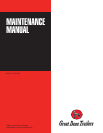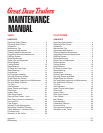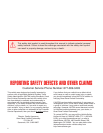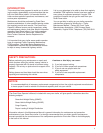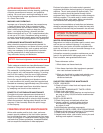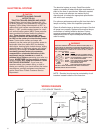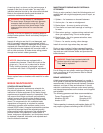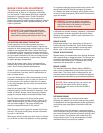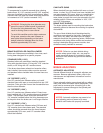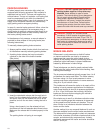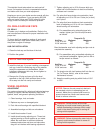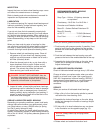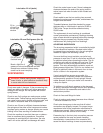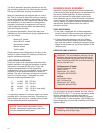
A warning decal, as shown on the previous page, is
located on the front of each trailer. You may trace
individual electrical circuits by the wire colors indicated.
Refer to the schematic drawing and the decal for
c
onductor numbers and wire colors.
Use only a 12-volt DC battery for checking lamps or
antilock brake systems. Never use battery chargers or
transformers.
Inspect all wiring to see that it is not damaged, and
that it is properly supported and protected, with all
connections tight. Frayed or damaged wiring should be
replaced with stranded cable of equal size or larger,
and should never be replaced with a smaller cable, or
with a solid conductor. All holes where wiring passes
through must contain rubber grommets.
Never replace fuses or breakers with metal foil or other
devices.
BRAKE MAINTENANCE
SCHEDULED MAINTENANCE
Establish a preventive maintenance schedule for
the periodic adjustment, cleaning, inspection, and
lubrication of brake equipment on the basis of past
experience and expected severity of operations. Take
into account that linings and drums are particularly
subject to wear and should not be allowed to wear
to the point where rivets or bolts may contact brake
drums. To compensate for this, schedule brake
inspections as frequently as required to maintain
satisfactory operation and maximum safety (not to
exceed 25,000 miles). Accepted maintenance practices
require that bearings should be adjusted properly
before making brake adjustments; that adjustments
provide uniform lining clearance, correct travel of
levers, and proper equalization; and that brakes should
be cleaned, inspected, lubricated, and adjusted each
time the hubs are removed.
MAINTENANCE DURING MAJOR OVERHAUL
OF BRAKES
During a major overhaul, check the following parts and
replace them with original equipment parts or equal, as
required:
1
. Spiders – for looseness or sheared fasteners.
2. Anchor pins – for wear or misalignment.
3. Brake shoes – for wear at anchor pin holes.
4. Cam shafts and cam shaft bearings or bushings –
for wear.
5. Shoe-return springs – replace during overhaul and
when you replace lining. Do not reuse springs.
6. Brake linings – for oil or grease saturation, wear,
loose rivets or bolts.
7. Drums – for cracks, scoring, other damage.
Install all new lock rings where they are used.
During a major overhaul, before reassembling parts
that have been inspected, lightly coat cam shaft bush-
ings and cam roller follower shafts and journals with
brake lubricant.
For all fittings on cam shafts, meter-type fittings that
have a maximum of 40 psi pressure relief or shutoff
are recommended.
BRAKE LUBRICANTS
A high-temperature waterproof grease in a number 1
NLGI grade to lubricate the brake actuating system is
recommended. It should be smooth textured, corrosion
resistant, and free of fillers and abrasives. It should
maintain a satisfactory softness under normal parking
and storage temperatures so the brakes can be applied
and released.
The following greases meet these recommendations:
Texaco Thermotex EP #1 Shell Darina #1
Marathon 528 HD Sunaplex #1 EP
Amdex #1 EP Philube B #1
Trailers operating in extremely cold weather (below -40˚ F)
may require a grease conforming to MIL-G-25013C.
WARNING Do not exceed 21 candlepower
for dome lamps. Stronger bulbs may generate
e
xcessive heat and start a cargo fire. Cargo
must be kept away from dome lamps. Dome
lamps must be turned off for over-the-road
operation.
WARNING Brake liners contaminated with
lubricant cannot be salvaged or cleaned.
They must be replaced.
NOTICE: Most trailers are equipped with a
sealed wiring harness. Check the circuits at the
plugs only – do not cut or probe test for shorts.
Every time the harness is unplugged, repack
connector with Grafo 112X grease or equivalent.
7



